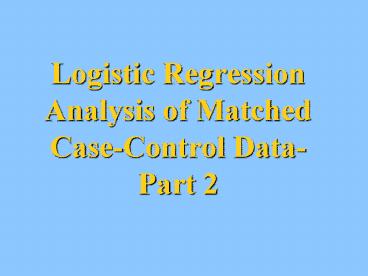Logistic Regression Analysis of Matched Case-Control Data- Part 2 - PowerPoint PPT Presentation
1 / 25
Title:
Logistic Regression Analysis of Matched Case-Control Data- Part 2
Description:
Logistic Regression Analysis of Matched Case-Control Data-Part 2 USING STATA S CLOGIT PROCEDURE TO CARRY OUT CONDITIONAL ML ESTIMATION OF MATCHED DATA USING ... – PowerPoint PPT presentation
Number of Views:164
Avg rating:3.0/5.0
Title: Logistic Regression Analysis of Matched Case-Control Data- Part 2
1
Logistic Regression Analysis of Matched
Case-Control Data-Part 2
2
EVW LOGISTIC MODEL FOR MATCHED DATA
Logit P(X) ? ?E ??1iV1i ??2iV2i
E??kWk
3
(No Transcript)
4
(No Transcript)
5
(No Transcript)
6
(No Transcript)
7
(No Transcript)
8
USING SASS PHREG PROCEDURE TO CARRY
OUTCONDITIONAL ML ESTIMATION OF MATCHED DATA
USING LOGISTIC REGRESSON
9
(No Transcript)
10
(No Transcript)
11
(No Transcript)
12
(No Transcript)
13
(No Transcript)
14
(No Transcript)
15
(No Transcript)
16
USING STATAS CLOGIT PROCEDURE TO CARRY
OUTCONDITIONAL ML ESTIMATION OF MATCHED DATA
USING LOGISTIC REGRESSON
17
(No Transcript)
18
. clogit case est gall fweightwgt,
strata(stratum)
19
. clogit case est gall fweightwgt,
strata(stratum) or
20
. clogit case est fweightwgt,
strata(stratum)
21
. clogit case est fweightwgt,
strata(stratum) or
22
(No Transcript)
23
SPSS SPSS does not perform conditional
logistic regression except in the special case in
which there is only one case per stratum, with
one or more controls. The SPSS survival
analysis procedure COXREG can be used to obtain
coefficient estimates equivalent to running a
conditional logistic regression. The process
is similar to that demonstrated for SAS with PROC
PHREG and the GALL dataset, although SAS is not
limited to the special case.
24
SPSS (continued) As with SAS, a time variable
must be created in the data, coded to indicate
that all cases had the event at the same time,
and all controls were censored at a later time.
In the GALL dataset, this time variable is
named survt ( SPSS dataset Is called gall.sav.)
25
SPSS (continued) The program code for the
gall.sav dataset (assuming one line of data for
each subject, I.e., no weight variable)
GET FILE'Agall.sav'. COXREG survt
/STATUScase(1) /STRATAstratum /METHODENTER
est gall /CRITERIAPIN(.05) POUT(.10)
ITERATE(20) . The model statement contains the
time variable (survt) followed by a backslash and
the case status variable (case) with the value
for cases (1) in parentheses.































